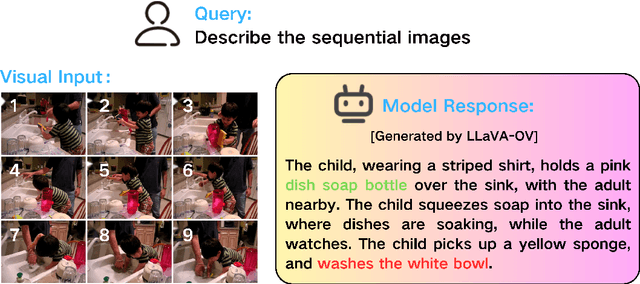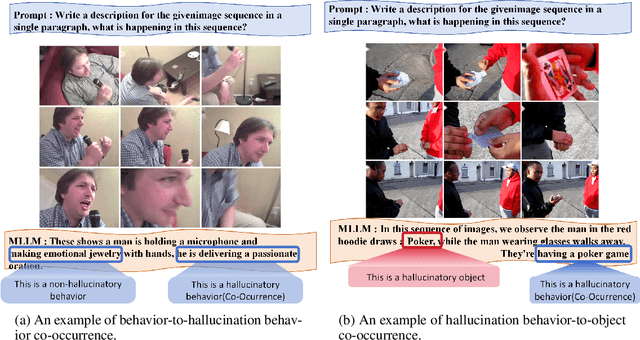Lijie Hu
Benchmarking and Mitigate Psychological Sycophancy in Medical Vision-Language Models
Sep 26, 2025Abstract:Vision language models(VLMs) are increasingly integrated into clinical workflows, but they often exhibit sycophantic behavior prioritizing alignment with user phrasing social cues or perceived authority over evidence based reasoning. This study evaluate clinical sycophancy in medical visual question answering through a novel clinically grounded benchmark. We propose a medical sycophancy dataset construct from PathVQA, SLAKE, and VQA-RAD stratified by different type organ system and modality. Using psychologically motivated pressure templates including various sycophancy. In our adversarial experiments on various VLMs, we found that these models are generally vulnerable, exhibiting significant variations in the occurrence of adversarial responses, with weak correlations to the model accuracy or size. Imitation and expert provided corrections were found to be the most effective triggers, suggesting that the models possess a bias mechanism independent of visual evidence. To address this, we propose Visual Information Purification for Evidence based Response (VIPER) a lightweight mitigation strategy that filters non evidentiary content for example social pressures and then generates constrained evidence first answers. This framework reduces sycophancy by an average amount outperforming baselines while maintaining interpretability. Our benchmark analysis and mitigation framework lay the groundwork for robust deployment of medical VLMs in real world clinician interactions emphasizing the need for evidence anchored defenses.
D-LEAF: Localizing and Correcting Hallucinations in Multimodal LLMs via Layer-to-head Attention Diagnostics
Sep 09, 2025Abstract:Multimodal Large Language Models (MLLMs) achieve strong performance on tasks like image captioning and visual question answering, but remain prone to hallucinations, where generated text conflicts with the visual input. Prior work links this partly to insufficient visual attention, but existing attention-based detectors and mitigation typically apply uniform adjustments across layers and heads, obscuring where errors originate. In this paper, we first show these methods fail to accurately localize problematic layers. Then, we introduce two diagnostics: Layer Image Attention Entropy (LIAE) which flags anomalous layers, and Image Attention Focus (IAF) which scores attention heads within those layers. Analysis shows that LIAE pinpoints faulty layers and IAF reliably ranks heads that warrant correction. Guided by these signals, we propose Dynamic Layer-wise Entropy and Attention Fusion (D-LEAF), a task-agnostic, attention-guided method that dynamically localizes and corrects errors during inference with negligible overhead. Results show our D-LEAF delivers a 53% relative improvement on standard captioning benchmarks, and on VQA both accuracy and F1-score improve by approximately 4%, substantially suppressing hallucinations while preserving efficiency.
Partitioner Guided Modal Learning Framework
Jul 15, 2025Abstract:Multimodal learning benefits from multiple modal information, and each learned modal representations can be divided into uni-modal that can be learned from uni-modal training and paired-modal features that can be learned from cross-modal interaction. Building on this perspective, we propose a partitioner-guided modal learning framework, PgM, which consists of the modal partitioner, uni-modal learner, paired-modal learner, and uni-paired modal decoder. Modal partitioner segments the learned modal representation into uni-modal and paired-modal features. Modal learner incorporates two dedicated components for uni-modal and paired-modal learning. Uni-paired modal decoder reconstructs modal representation based on uni-modal and paired-modal features. PgM offers three key benefits: 1) thorough learning of uni-modal and paired-modal features, 2) flexible distribution adjustment for uni-modal and paired-modal representations to suit diverse downstream tasks, and 3) different learning rates across modalities and partitions. Extensive experiments demonstrate the effectiveness of PgM across four multimodal tasks and further highlight its transferability to existing models. Additionally, we visualize the distribution of uni-modal and paired-modal features across modalities and tasks, offering insights into their respective contributions.
The Compositional Architecture of Regret in Large Language Models
Jun 18, 2025



Abstract:Regret in Large Language Models refers to their explicit regret expression when presented with evidence contradicting their previously generated misinformation. Studying the regret mechanism is crucial for enhancing model reliability and helps in revealing how cognition is coded in neural networks. To understand this mechanism, we need to first identify regret expressions in model outputs, then analyze their internal representation. This analysis requires examining the model's hidden states, where information processing occurs at the neuron level. However, this faces three key challenges: (1) the absence of specialized datasets capturing regret expressions, (2) the lack of metrics to find the optimal regret representation layer, and (3) the lack of metrics for identifying and analyzing regret neurons. Addressing these limitations, we propose: (1) a workflow for constructing a comprehensive regret dataset through strategically designed prompting scenarios, (2) the Supervised Compression-Decoupling Index (S-CDI) metric to identify optimal regret representation layers, and (3) the Regret Dominance Score (RDS) metric to identify regret neurons and the Group Impact Coefficient (GIC) to analyze activation patterns. Our experimental results successfully identified the optimal regret representation layer using the S-CDI metric, which significantly enhanced performance in probe classification experiments. Additionally, we discovered an M-shaped decoupling pattern across model layers, revealing how information processing alternates between coupling and decoupling phases. Through the RDS metric, we categorized neurons into three distinct functional groups: regret neurons, non-regret neurons, and dual neurons.
Flattery in Motion: Benchmarking and Analyzing Sycophancy in Video-LLMs
Jun 08, 2025Abstract:As video large language models (Video-LLMs) become increasingly integrated into real-world applications that demand grounded multimodal reasoning, ensuring their factual consistency and reliability is of critical importance. However, sycophancy, the tendency of these models to align with user input even when it contradicts the visual evidence, undermines their trustworthiness in such contexts. Current sycophancy research has largely overlooked its specific manifestations in the video-language domain, resulting in a notable absence of systematic benchmarks and targeted evaluations to understand how Video-LLMs respond under misleading user input. To fill this gap, we propose VISE (Video-LLM Sycophancy Benchmarking and Evaluation), the first dedicated benchmark designed to evaluate sycophantic behavior in state-of-the-art Video-LLMs across diverse question formats, prompt biases, and visual reasoning tasks. Specifically, VISE pioneeringly brings linguistic perspectives on sycophancy into the visual domain, enabling fine-grained analysis across multiple sycophancy types and interaction patterns. In addition, we explore key-frame selection as an interpretable, training-free mitigation strategy, which reveals potential paths for reducing sycophantic bias by strengthening visual grounding.
Mitigating Behavioral Hallucination in Multimodal Large Language Models for Sequential Images
Jun 08, 2025



Abstract:While multimodal large language models excel at various tasks, they still suffer from hallucinations, which limit their reliability and scalability for broader domain applications. To address this issue, recent research mainly focuses on objective hallucination. However, for sequential images, besides objective hallucination, there is also behavioral hallucination, which is less studied. This work aims to fill in the gap. We first reveal that behavioral hallucinations mainly arise from two key factors: prior-driven bias and the snowball effect. Based on these observations, we introduce SHE (Sequence Hallucination Eradication), a lightweight, two-stage framework that (1) detects hallucinations via visual-textual alignment check using our proposed adaptive temporal window and (2) mitigates them via orthogonal projection onto the joint embedding space. We also propose a new metric (BEACH) to quantify behavioral hallucination severity. Empirical results on standard benchmarks demonstrate that SHE reduces behavioral hallucination by over 10% on BEACH while maintaining descriptive accuracy.
Efficient Text-Attributed Graph Learning through Selective Annotation and Graph Alignment
Jun 08, 2025Abstract:In the realm of Text-attributed Graphs (TAGs), traditional graph neural networks (GNNs) often fall short due to the complex textual information associated with each node. Recent methods have improved node representations by leveraging large language models (LLMs) to enhance node text features, but these approaches typically require extensive annotations or fine-tuning across all nodes, which is both time-consuming and costly. To overcome these challenges, we introduce GAGA, an efficient framework for TAG representation learning. GAGA reduces annotation time and cost by focusing on annotating only representative nodes and edges. It constructs an annotation graph that captures the topological relationships among these annotations. Furthermore, GAGA employs a two-level alignment module to effectively integrate the annotation graph with the TAG, aligning their underlying structures. Experiments show that GAGA achieves classification accuracies on par with or surpassing state-of-the-art methods while requiring only 1% of the data to be annotated, demonstrating its high efficiency.
Stable Vision Concept Transformers for Medical Diagnosis
Jun 05, 2025Abstract:Transparency is a paramount concern in the medical field, prompting researchers to delve into the realm of explainable AI (XAI). Among these XAI methods, Concept Bottleneck Models (CBMs) aim to restrict the model's latent space to human-understandable high-level concepts by generating a conceptual layer for extracting conceptual features, which has drawn much attention recently. However, existing methods rely solely on concept features to determine the model's predictions, which overlook the intrinsic feature embeddings within medical images. To address this utility gap between the original models and concept-based models, we propose Vision Concept Transformer (VCT). Furthermore, despite their benefits, CBMs have been found to negatively impact model performance and fail to provide stable explanations when faced with input perturbations, which limits their application in the medical field. To address this faithfulness issue, this paper further proposes the Stable Vision Concept Transformer (SVCT) based on VCT, which leverages the vision transformer (ViT) as its backbone and incorporates a conceptual layer. SVCT employs conceptual features to enhance decision-making capabilities by fusing them with image features and ensures model faithfulness through the integration of Denoised Diffusion Smoothing. Comprehensive experiments on four medical datasets demonstrate that our VCT and SVCT maintain accuracy while remaining interpretable compared to baselines. Furthermore, even when subjected to perturbations, our SVCT model consistently provides faithful explanations, thus meeting the needs of the medical field.
Understanding How Value Neurons Shape the Generation of Specified Values in LLMs
May 23, 2025Abstract:Rapid integration of large language models (LLMs) into societal applications has intensified concerns about their alignment with universal ethical principles, as their internal value representations remain opaque despite behavioral alignment advancements. Current approaches struggle to systematically interpret how values are encoded in neural architectures, limited by datasets that prioritize superficial judgments over mechanistic analysis. We introduce ValueLocate, a mechanistic interpretability framework grounded in the Schwartz Values Survey, to address this gap. Our method first constructs ValueInsight, a dataset that operationalizes four dimensions of universal value through behavioral contexts in the real world. Leveraging this dataset, we develop a neuron identification method that calculates activation differences between opposing value aspects, enabling precise localization of value-critical neurons without relying on computationally intensive attribution methods. Our proposed validation method demonstrates that targeted manipulation of these neurons effectively alters model value orientations, establishing causal relationships between neurons and value representations. This work advances the foundation for value alignment by bridging psychological value frameworks with neuron analysis in LLMs.
Understanding the Repeat Curse in Large Language Models from a Feature Perspective
Apr 19, 2025Abstract:Large language models (LLMs) have made remarkable progress in various domains, yet they often suffer from repetitive text generation, a phenomenon we refer to as the "Repeat Curse". While previous studies have proposed decoding strategies to mitigate repetition, the underlying mechanism behind this issue remains insufficiently explored. In this work, we investigate the root causes of repetition in LLMs through the lens of mechanistic interpretability. Inspired by recent advances in Sparse Autoencoders (SAEs), which enable monosemantic feature extraction, we propose a novel approach, "Duplicatus Charm", to induce and analyze the Repeat Curse. Our method systematically identifies "Repetition Features" -the key model activations responsible for generating repetitive outputs. First, we locate the layers most involved in repetition through logit analysis. Next, we extract and stimulate relevant features using SAE-based activation manipulation. To validate our approach, we construct a repetition dataset covering token and paragraph level repetitions and introduce an evaluation pipeline to quantify the influence of identified repetition features. Furthermore, by deactivating these features, we have effectively mitigated the Repeat Curse.
 Add to Chrome
Add to Chrome Add to Firefox
Add to Firefox Add to Edge
Add to Edge